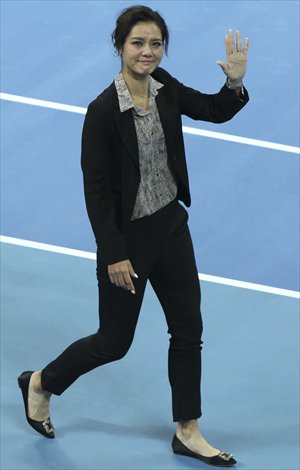HOME >> SPORTS
Li’s retirement leaves gap in Chinese tennis
Source:Xinhua Published: 2014-12-26 5:03:03
Injuries force top Asian player to quit at prime time in career

Chinese tennis great Li Na waves to fans in a retirement ceremony during the China Open on September 30 in Beijing. Photo: CFP
Li Na wasn't just a Chinese trailblazer, she was one of the best female players ever to play the sport. But injuries caught up with her in 2014 and she had to say farewell, leaving a large rift in the Chinese tennis scene.
It was one of the most surprising retirements in women's tennis. Even at the age of 32, Li was truly in the prime of her career. Earlier in the year she had not only captured her second Grand Slam title at the Australian Open, but also ascended to No.2 in the world, with only Serena Williams keeping her from the top spot.
Longtime injuries
Although Li suffered early exits at the French Open and Wimbledon, the Chinese still headed into the summer hard-court season with a world No.2 ranking.
But after announcing she wouldn't be able to play the whole summer hard-court season due to a knee injury, rumors started swirling.
On September 19, just a few days before her hometown Wuhan made its WTA debut, she announced retirement in an open letter.
Li said in the letter, "After four knee surgeries and hundreds of shots injected into my knee weekly to alleviate swelling and pain, my body is begging me to stop the pounding. My previous three surgeries were on my right knee. My most recent knee surgery took place this July and was on my left knee. After a few weeks of post-surgery recovery, I tried to go through all the necessary steps to get back on the court. While I've come back from surgery in the past, this time it felt different.
"As hard as I tried to get back to being 100 percent, my body kept telling me that, at 32, I will not be able to compete at the top level ever again. The sport is just too competitive, too good, to not be 100 percent."
Asian legacy
Li left a legacy, not just for China, but for Asia as well.
She was the highest-ranked Asian player in history, male or female. Japan's Kimiko Date-Krumm held the previous record of No.4 in the world. Li was also the first player from Asia to win a Grand Slam title. She did it twice at the 2011 French Open and the 2014 Australian Open. She also gives hope to all the players grinding it out year after year with Grand Slam dreams - she was the best late bloomer in the Open Era, winning her first two majors at age 29 and 31.
"Li Na is China's first Grand Slam singles winner and is definitely instrumental in expanding the game in China, where tennis participation doubled in the past five years," said Zhang Qi, former Chinese national women's tennis team coach.
"Just as the sport is taking root in China, it loses its biggest icon. This is not good for Chinese succession planning in tennis. The country needs a new star."
After Li's exit, 28-year-old Peng Shuai, this year's US Open semifinalist, became China's top female player, ranked 21st in the world. There are just three others in top 100: Zhang Shuai (61), Zheng Jie (91) and Zheng Saisai (100). In men's tennis, the best Chinese player is Zhang Ze, who is ranked at 184 in the world.
"I don't think we can have a big star like Li Na in the next few years. Li is talented and hard-working. The young guns just need to learn so many things from these trailblazers," said Zhang Qi, who is now guiding the provincial tennis team of Central China's Henan Province.
"There are some upbeat forecasts," said Wang Peng, the current national women's tennis team coach. "The sport has become more and more lucrative and players are going all in for it, so there is more international competition than before. Now, the top 10 players are coming from 10 different countries and regions.
"Although Li can't be duplicated, we are able to have more Chinese players in the top 50 in the next few years and we're working on it," Wang said.
Posted in: Feature